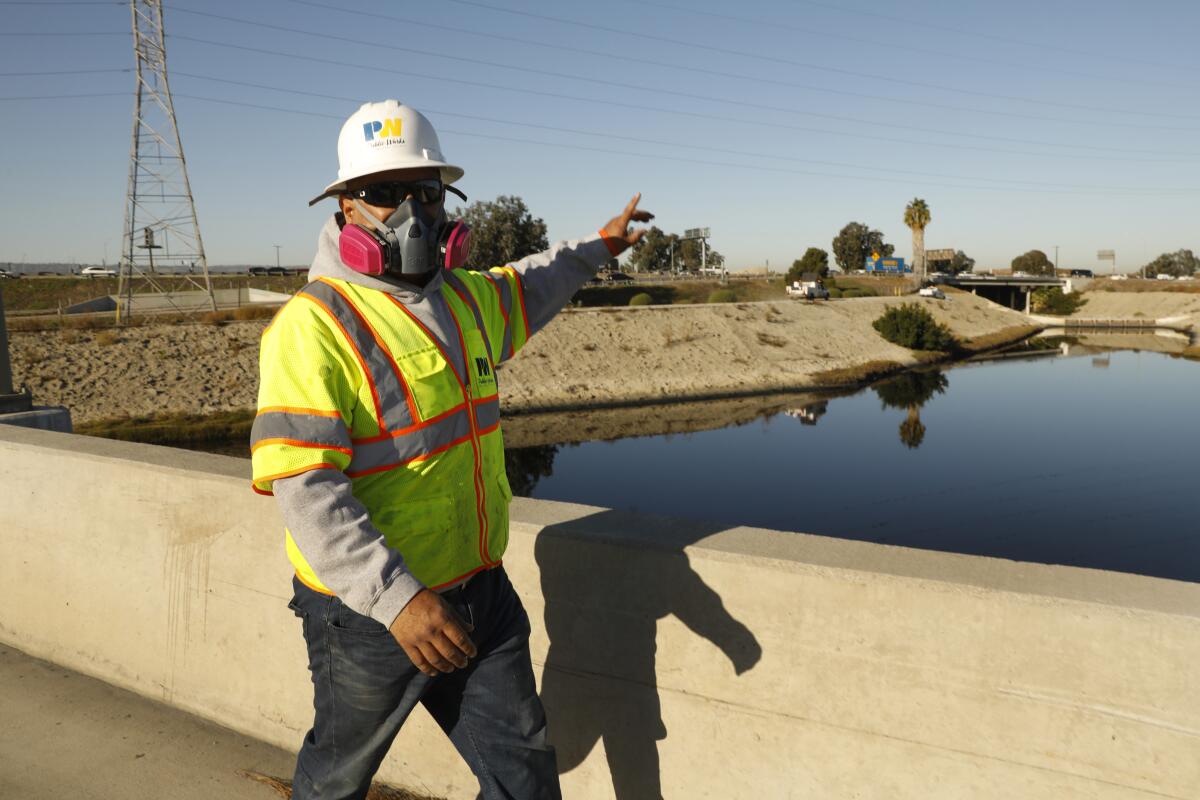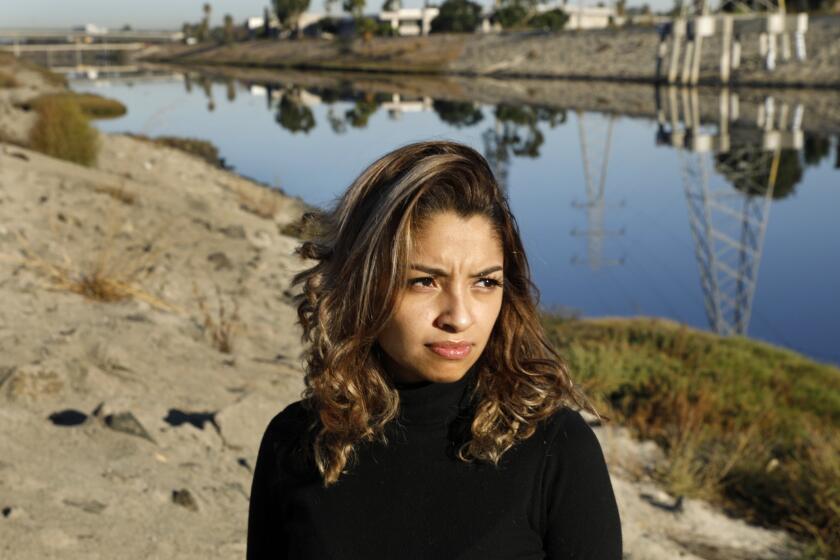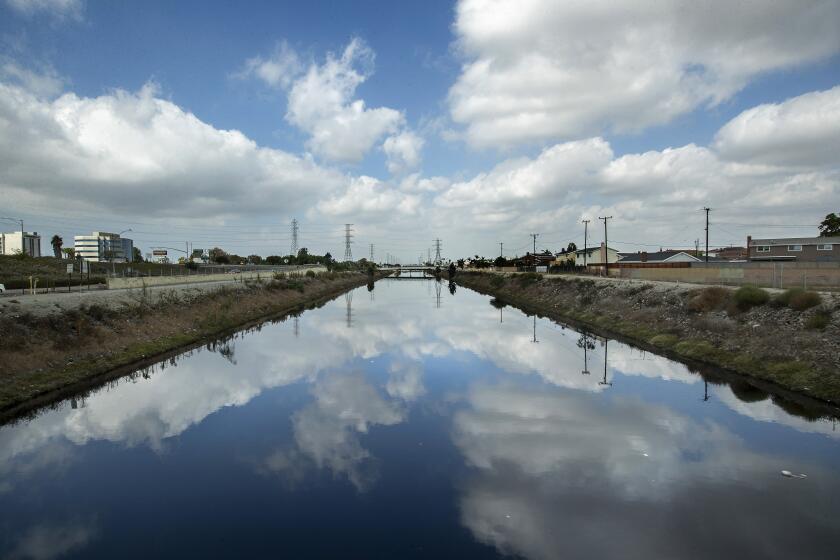Congresswoman calls for emergency declaration over foul odor in Carson

- Share via
Calling it an “issue of health and environmental injustice,” Rep. Nanette Barragán (D-San Pedro) on Monday asked Gov. Gavin Newsom to declare a state of emergency over an overpowering foul smell that has sickened residents of Carson and surrounding communities for more than two weeks.
The ongoing stench — which Los Angeles County officials say is caused by hydrogen sulfide coming from decaying vegetation in the Dominguez Channel — was first reported to the South Coast Air Quality Management District on Oct. 3.
It took 12 days for county crews to begin treating the flood control channel to mitigate the odor.
“The lack of a swift response by the responsible government agencies has been very disappointing,” Barragán wrote in a letter to Newsom.
In Carson, a smell like rotten eggs from the Dominguez Channel has been sickening residents for nearly two weeks. Anger is growing.
Residents say noxious fumes from the hydrogen sulfide have caused headaches, nausea, burning eyes and dizziness.
They have been advised by county health officials to close their doors and windows — even though many do not have air conditioning — and to temporarily relocate if the smell makes them too sick.
Last week, county officials announced that residents can be reimbursed for air purifiers and hotels. But it could take weeks to get the reimbursements.
“Unfortunately, this plan provides insufficient relief and is inequitable to low-income residents,” Barragán, whose district includes Carson, told the governor. “Many of my constituents cannot afford to purchase an air filter or pay hotel expenses for a long duration.
“These residents need direct aid, which is why I am asking you to declare a State of Emergency so that residents can receive direct relief and not be indebted by this event.”
Residents have blasted city and county officials for taking so long to act, and questions remain over whether communication breakdowns among different agencies led to the delay.
Air quality officials did not notify the L.A. County Department of Public Works, which manages the Dominguez Channel, until Oct. 7, said department spokesman Kerjon Lee.
The Carson City Council did not declare the smell a public nuisance until Oct. 11 — eight days after it was officially reported.
Elevated levels of hydrogen sulfide were confirmed Sunday evening in Carson, which led some residents to experience nausea, headaches, and eye, nose or throat irritation.
“We are behind, and I think as a city government we should just admit our mistake,” Carson Mayor Pro Tem Jim Dear said during a special meeting Thursday night. “We should have acted immediately.”
The council late that night approved its own reimbursement program, which will include medical expenses and come out of $100,000 in emergency funds.
During that meeting, City Council members said they would ask Newsom to declare an emergency. By then, the South Coast air district had received more than 2,000 complaints, mostly from Carson.
Elected officials in neighboring Long Beach had already announced that they would urge their city manager to seek help from the state and federal environmental protection agencies, citing more than 125 complaints about the odor from residents of their city.
“I have been monitoring this situation closely and am concerned about its impact on Southern California residents,” Long Beach Vice Mayor Rex Richardson, who also serves on the South Coast air district’s governing board, said in a statement Thursday.
“Although we have been working with local agencies to address this situation, we are requesting our state and federal officials to provide urgent assistance in the remediation and response to this public nuisance that has impacted the quality of life of thousands of families across the region.”
L.A. County crews on Friday began spraying the flood control channel with a biodegradable odor neutralizer called Epoleon that will convert the hydrogen sulfide to a salt. The odor was expected to dissipate within five days of treatments beginning, officials said.
In a normal year, storm water would have washed away more of the underwater vegetation that is now decomposing. This year, the drought caused additional buildup, officials said.
Beneath the surface, the vegetation was decaying — and the process may have been sped up by pallets and cardboard dumped upstream, which provided food for the bacteria, according to the public works department.
County agencies are investigating whether a fire at a pallet yard led to the dumping.
In her letter, Barragán said it was “extremely frustrating that the cause of the hydrogen sulfide gas has not been determined, aside from the fact it’s coming from the Dominguez Channel.”
Known as “sewer gas,” hydrogen sulfide is produced by decaying organic matter, such as dead animals or dying plants. Humans smell it at very low levels, which helps us notice when food is rotten.
The highest levels of hydrogen sulfide in the air have been detected near the channel’s intersection with Avalon Boulevard near the 405 Freeway, officials said. A nearby shopping district includes the South Bay Pavilion and an Ikea.
Dr. Muntu Davis, the county’s health officer, told The Times last week that levels in the air are “well below what’s actually hazardous.”
The levels were too low to cause long-term health effects, he said, but are constantly being monitored.
More to Read
Sign up for Essential California
The most important California stories and recommendations in your inbox every morning.
You may occasionally receive promotional content from the Los Angeles Times.













